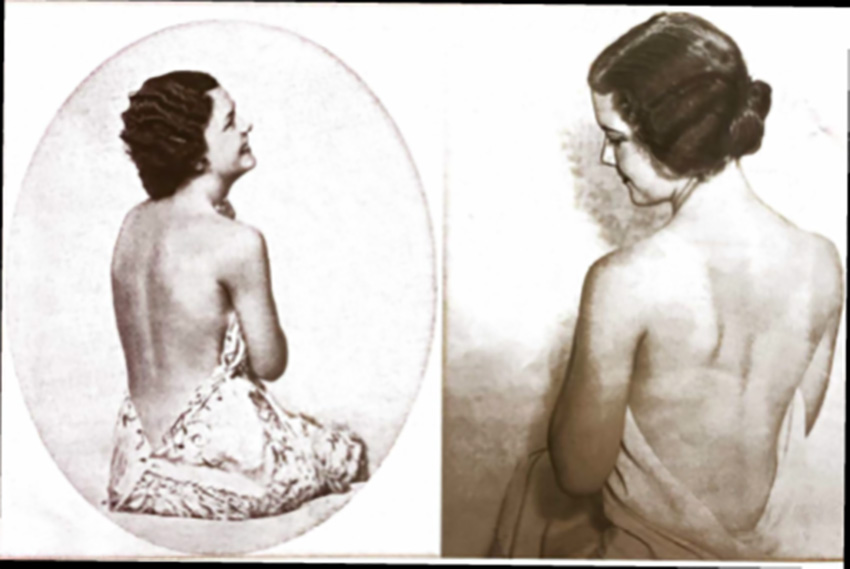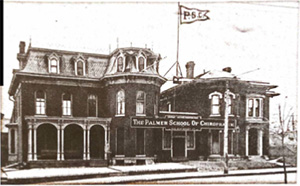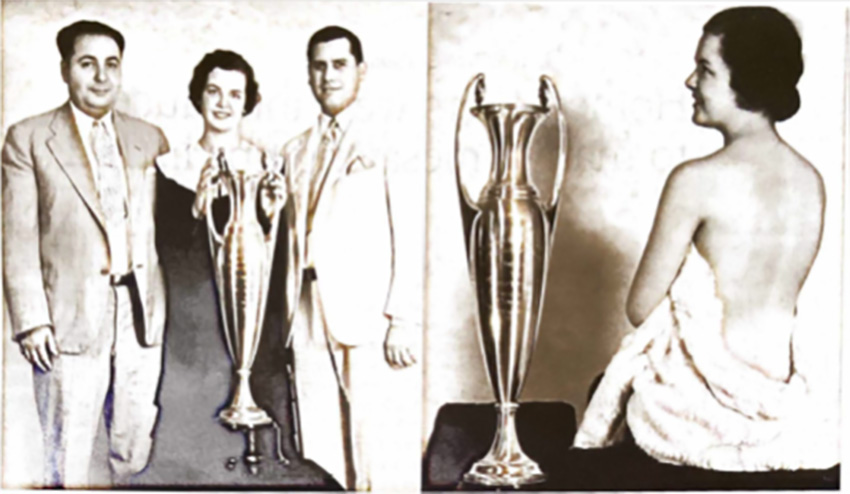Having a “perfect back” helped Louise Goodwin McKlveen ’35 attend Grinnell College.
The following article, written by Mary Jo Nissen ’72, originally was published by the Iowa History Journal.
Iowans played central roles in the development of the chiropractic profession. Indeed, it is said that chiropractic was born on Sept. 18, 1895, in Davenport when D.D. Palmer's adjustment of the spine of Harvey Lillard, who suffered from deafness, caused Lillard's hearing to return to normal. The Palmer College of Chiropractic that Palmer established in Davenport was the first in the world and continues to exist as one of only 19 accredited chiropractic colleges in the United States. Iowa was the home of many of the early leaders in chiropractic who helped to establish, defend and publicize the practice.
Another Iowan also had a starring role in the early days of chiropractic: Louise Goodwin ’35 of Baxter was named "Miss Perfect Back of America" by the National Chiropractic Association (NCA). This is the story of Goodwin's participation in that contest, how and why the NCA established it, and the roles that other Iowans played in it.
Goodwin won the national title in 1933, but her experience with back contests began two years before then. It was the summer of 1931, she had just graduated from Baxter High School at the age of 16, and her family took a trip to southern California. While there, Goodwin's mother noticed a newspaper clipping about a "Miss Perfect Back" contest to be held in Los Angeles, and the family decided that Goodwin should enter it. She was a beautiful girl, and it wasn't impossible that she had a perfect back. Another factor that probably played a role in this decision was that Goodwin's first cousin was Claire Dodd, also born in Baxter, who was beginning her career as a Hollywood movie star. While Goodwin and her family were visiting California in 1931, the first of Dodd's nearly 60 films was released, so they might all have been a bit starstruck and hopeful that Goodwin could follow in her cousin's footsteps.
 Grinnellian and Iowan Louise Goodwin was chosen as "Miss Perfect Back of America" in 1933. These pictures appeared in the 1933 issue of The Chiropractic Journal. All photos courtesy of Mary Jo Nissen.
Grinnellian and Iowan Louise Goodwin was chosen as "Miss Perfect Back of America" in 1933. These pictures appeared in the 1933 issue of The Chiropractic Journal. All photos courtesy of Mary Jo Nissen.
When Goodwin and her mother went to Los Angeles to register for the contest, they were told that registration had closed two days previously, but the director of the contest decided she could enter anyway. Out of the 520 young women who entered the contest, 46 finalists, including Goodwin, donned swimsuits for the final judging. Goodwin did not take first place, but the judges named her the "most perfect brunette" and awarded her a gold medal and a plaque.
Let's consider this idea of a perfect back contest. Who came up with it, and when? Was it really about backs, or was it a beauty contest? The first such contest in North America was announced in 1921. Frederic P. Millard, an osteopath who had graduated from the American School of Osteopathy in Kirksville, Mo., was the founder and at that time president of the National League for the Prevention of Spinal Curvature, and he spearheaded the idea of holding a contest for the best spine in North America. Newspapers all across the United States advertised the contest, which offered a prize of $1,000 to the winner. Women could enter by submitting two photos of their unclothed back from neck to hips - one full on and one from the side - as well as a certificate from an osteopath who had examined their back. Judging was based entirely on the photographs and the report of the osteopath. Because of the relative ease of entering the contest and the size of the prize money, more than 40,000 women entered and the media frenzy was extensive.
In interviews with reporters from various newspapers, Millard emphasized the value of screening for scoliosis and the contribution of good posture to one's wellbeing. The fact that entrants sent in photos only of their back also suggests that this was not primarily a beauty contest. As the Washington Times noted at the time, "Girls, you can make money if your back is the most beautiful in the country. You needn't have a face worth looking at."
Millard's group surely knew that regardless of their aims, the competition would be seen as a beauty contest. The Roaring Twenties were just beginning, and the many strictures on women's lives (and bodies) were starting to loosen. In fact, the first Miss America contest was also held in 1921 as a way to increase tourism to Atlantic City, NJ., and it included a "Bather's Revue" in which the contestants wore bathing suits – with tights on their legs instead of bloomers. Presumably the National League for the Prevention of Curvature of the Spine realized that even the idea of the exposure of women's backs would attract the excited attention of the public.
During the next decade, beauty contests, however they were framed, became more common. In Los Angeles, an ambitious chiropractor named Charles Wood advanced the idea of having chiropractic organizations hold perfect back contests, and he organized several such contests, all held in Los Angeles, beginning in 1925. These contests did not have the educational veneer regarding the importance of the spine for good health that Millard's contest did. The panel of judges, headed by Wood, did examine the women's backs, but these competitions seemed much more like beauty contests. For example, the 1929 contest that Wood ran offered prizes not only for perfect backs but also for ideal blonde, brunette, auburn, raven-haired, best personality and best figure.
Wood ran the contest that Goodwin entered in Los Angeles in 1931. Although he promoted his chiropractic association and the perfect back contest as being national in reach, they were in reality California enterprises. Wood did not see as many applicants as he had hoped. He told the Los Angeles Times in early July that there was room for 750 applicants, but he had so far received only 52 entries and the contest was in three weeks. He was probably very pleased to see a lovely young woman from Iowa walk in the door even though she was two days late.
Happy to be named the "most perfect brunette," Goodwin returned to Baxter later that summer. She soon had to decide what was next for her. She considered attending either the University of Iowa, where another of her cousins was a student, or Grinnell College. She decided on Grinnell College. It was closer to Baxter and Grinnell offered her generous financial support in the form of loans and campus jobs, without which she could not have attended college. Her parents' financial situation was never comfortable, and this was during the Great Depression, which had made things even more difficult for them. Goodwin loved Grinnell. Her world there was full of classes, theater and musical organizations, social events and boyfriends. She evidently lacked the interest or the resources to enter any of the regional back contests that were held during her first year at Grinnell.
 The Palmer School of Chiropractic
The Palmer School of Chiropractic
in Davenport, 1912.
The world of chiropractic was not as rosy. The American Medical Association (AMA) had been criticizing chiropractic for years and chiropractic had provided an easy target. There was plenty of quackery and the training was inadequate. ln 1915, Dr. Thomas Duhigg, M.D., of Des Moines, published an article in the Journal of the American Medical Association (JAMA) in which he reported that none of the three chiropractic colleges in Davenport had a library, a hospital, a laboratory "that is worthy of the name," or the means to perform dissections except on dogs. By the early 1930s criticism of chiropractic by the AMA intensified through Morris Fishbein, the editor of JAMA from 1924 to 1950, who took the issue to the general public. His efforts helped the passage of basic science requirements in several states, including Iowa, between 1925 and 1935. The requirement for graduates of chiropractic colleges to pass basic science examinations that covered anatomy, physiology and pathology sharply reduced the number of practitioners.
In addition, early practitioners of chiropractic had difficulty agreeing on several things, including a philosophy and an organization to represent its interests. Founding father D.D. Palmer of Davenport and his followers (the "straights") believed that chiropractic should be limited to the manual manipulation of the spine, but others (the "mixers") were in favor of a broader scope of practice and the use of instrumentation. Solon Massey Langworthy was a graduate of Palmer's college in Davenport, but as he built his practice in Cedar Rapids his philosophy strayed from Palmer's "straight" doctrine. He opened his own college of chiropractic in Cedar Rapids and from that group of "mixer" students and alumni began the first national association of chiropractors in 1905. In response, B.J. Palmer, who was carrying on his father's efforts, founded a competing organization of "straights" the following year. Those were only the first of several splinter organizations across the country.
Faced with the challenges from the AMA, the need for criminal defense of chiropractors who were charged with practicing medicine without a license, and the push for educational standards, chiropractors slowly began to lay aside their differences to create a unified front and the National Chiropractic Association (NCA) was born in 1933. Several Iowans played crucial roles in this effort, most notably Loran M. Rogers and James E. Slocum, both of Webster City. With Rogers serving as executive secretary and Slocum as director of public relations, it is fair to say that Webster City was the headquarters of the NCA for years. Rogers began publishing the organization's official organ, The Chiropractic Journal, and was its editor for more than 30 years, writing an editorial for each monthly issue as well as many other columns on the status of the chiropractic practice.
ln its very first issue, the editorial page excitedly announced "one of the most far-reaching publicity programs that has ever come before the Chiropractic profession": The NCA would hold the National Most Perfect Back contest in 1933. After listing eight benefits that this contest would bring to chiropractic, it encouraged each state organization to conduct a statewide contest; it outlined 18 rules to be followed in those contests; and it promised the assistance of the national organization, including the provision of Chiropractic and Layman's Score Charts for the judges. State committees were advised to provide contestants with distinctive gowns (full-length and with the back showing) and to reward the winner of the state contest with a fully paid trip to compete in the national contest.
Even before the national contest was announced, the Iowa Chiropractic Association had held its contest at its annual convention in Des Moines in October 1932. Goodwin, 18, won the title, Rogers put her on the cover of the inaugural issue, and in August 1933 she was on her way to Denver, Colo., for the first convention of the NCA. Once there, she had her back x-rayed and examined by the chiropractors who served as judges. There was also a panel of "artistic judges" composed of two journalists from the Denver newspapers, the owner of a jewelry store and a representative from the Denver Art College.
The contest rules, as laid out in the Chiropractic Journal, stipulated that the chiropractic judging should take place "in a private room with the three judges present and the entrants in groups of six or eight," and the lay judging should take place with all finalists and judges present. The rules also mentioned the involvement of a "lady chiropractor" in details concerning gowns and the availability of a changing room with a full-length mirror. It would not have been difficult to find female chiropractors to fulfill these duties because chiropractic colleges, unlike medical schools, were happy to admit women almost from the beginning and several women held leadership roles in the chiropractic organizations.
 Louise Goodwin received a trophy, cash prize and scholarship for being named "Miss Perfect Back of America" in 1933 at the national contest held in Denver, Colorado.
Louise Goodwin received a trophy, cash prize and scholarship for being named "Miss Perfect Back of America" in 1933 at the national contest held in Denver, Colorado.
Goodwin won the contest and was named "Miss Perfect Back of America" at an event open to the public at the Denver City Auditorium before a crowd of 3,600 people. She received $500 in cash, a scholarship worth $650 to a chiropractic college of her choice and an inscribed silver trophy that was at least half her height. There followed a program with a talk by Webster City's J.E. Slocum on chiropractic and public health, and a performance by the Martin Brothers Acrobatic Troupe featuring Robert and Walter Martin, two chiropractors from Belle Plaine. The audience was told that when Walter Martin was young, he received a serious injury chat caused total paralysis, but through the adjustments and care of a chiropractor, he fully regained muscular control ̶ as demonstrated by the acrobatic feats he and his brother were about to display.
Goodwin was kept busy during the rest of the convention, meeting people and posing for photographs, some of which were carried by the Associated Press and published in newspapers across the country. Other photos of her appeared on the covers of two more issues of The Chiropractic Journal and within articles in another two. On the final evening of the convention, she got to enjoy the grand Dinner Dance, at which the band played "Iowa."
Once back in Iowa, Goodwin returned to Grinnell College, having no desire to use her scholarship to attend a chiropractic college. She was as busy as ever with her academic and social activities, but she complied with multiple requests from the NCA despite the absence of any contractual requirement to do so. She sang at chiropractic association meetings in Pella and Des Moines, and traveled to Pittsburgh, Pa., for the 1935 NCA convention.
She also wrote an essay for The Chiropractic Journal at the request of Loran Rogers shortly after the Denver convention. The essay, titled "How I Won," outlined the basics of her competition in the 1931 and 1933 contests, but it also included statements promoting chiropractic, including this: "l want to state my profound faith in Chiropractic and its future. I marvel at the profession and the results which are achieved. It cannot help but move ahead to greater heights," a bit of rhetoric that might have originated from the pen of Rogers rather than Goodwin, who during the rest of her life never received chiropractic treatment.
On the whole, Goodwin's experiences with the back contests were positive. She broadened her horizons beyond Iowa, and most significantly, the $500 prize money covered two years of tuition at Grinnell.
Rogers and his colleagues continued to build their organization of chiropractors, which eventually became today's American Chiropractic Association, but they held only two more national back contests. Although beauty pageants sponsored by other organizations and companies grew in number and popularity, competitions based on one's spine disappeared. The public didn't seem to mind. As the Cordova, Ala., Daily News quoted a local man, "It will be a great relief when business depression is over and there is employment once more for everyone – when the 'experts' can find something to do besides conduct nationwide searches for 'the perfect back,' the 'perfect feminine foot,' the 'perfect elbow,' and so on."
—by Mary Jo Nissen ’72